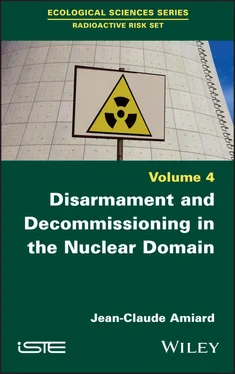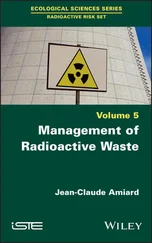By declaring its renunciation of weapons of mass destruction in December 2003, Libya revealed the existence of a nuclear program for military purposes, unsuspected by the IAEA. While taking advantage, officially, of its adherence to the NPT and of a safeguards agreement with the IAEA, Libya had been able to import certain nuclear materials, carry out conversion activities, set up a centrifuge park intended to enrich uranium and obtain documentation relating to the design and manufacture of nuclear weapons [CHE 10]. This action was the work of A.Q. Khan, who sold the plans for a bomb and first-generation centrifuges to the Libyan President Gaddafi.
Finally, very serious doubts were expressed about Syria’s nuclear activities. The American intelligence services transmitted information to the IAEA, that the installation destroyed by the Israeli air force in September 2007 at the Dair Alzour site, was a North Korean-designed nuclear reactor in the process of being completed. Similar to the one at Yongbyon, it was intended for the manufacture of weapon-grade plutonium that could be used to make a nuclear weapon. In 2009, two years later, the IAEA had still not obtained elements that would allow the Syrian authorities to deny the military vocation of this site [CHE 10].
1.5.2.5. The case of North Korea
Similarly, North Korea, which joined the NPT in 1985, has delayed concluding a comprehensive safeguards agreement with the IAEA for several years. This agreement was concluded a few days after the January 20, 1992 declaration on the denuclearization of the Korean Peninsula, in which both Koreas “ agree not to test, manufacture, produce, receive, possess, stockpile, deploy or use nuclear weapons ”. At that time, suspicions about the conduct of military nuclear activities were already widely shared in the international community. In fact, the North Korean authorities immediately obstructed the verifications that the IAEA intended to carry out as part of the implementation of the safeguards agreement, going so far as to announce, in March 1993, their withdrawal from the NPT, a decision they would go back on three months later.
In early 1994, the Americans discovered that the North Koreans had begun to produce plutonium. President Bill Clinton wanted to make a pre-emptive strike on the reactor, but President Jimmy Carter went to Pyongyang and negotiated with Kim Il Sung, and then, following the latter’s death in July 1994, with his son Kim Jong-il. At the end of the agreement, concluded in October 1994 with the United States, North Korea froze its military-scale activities, notably the Yongbyon reactor and reprocessing facilities intended to produce plutonium, in exchange for the construction of two light-water reactors by an international consortium (KEDO) and the delivery, until their entry into service, of 500,000 tons of oil per year. The United States did not respect this agreement. Oil deliveries carried on despite North Korean complaints in 1997, which explained the North Korean position [MOR 18]. Moreover, this agreement did not improve the IAEA’s ability to control the non-diversion of nuclear materials. Also, no guarantee could be obtained on the existence of plutonium coming from the Yongbyon reactor, and whether there was a sufficient quantity to build one or more nuclear devices, before the suspension of its operation. On the contrary, from 1994 to 2002, North Korea pursued, without the knowledge of the international community, a program of uranium enrichment. It recognized this fact in 2002, which led to its withdrawal from the NPT in 2003 [CHE 10].
1.5.2.6. The case of Iran
In Iran, it was opposition movements that revealed, in the summer of 2002, the existence of the uranium conversion facility in Isfahan, the uranium enrichment facility in Natanz, the heavy water plant and the reactor under construction in Arak. The IAEA was not informed of their existence and could therefore exercise no control over them. As the IAEA later stressed:
[…] many aspects of Iran’s nuclear fuel cycle activities and experiments, particularly in the fields of uranium enrichment and conversion, as well as research concerning plutonium, have not been declared to the Agency, contrary to Iran’s obligations under its Safeguards Agreement, since ‘Iran’s policy of concealment’ has led to numerous breaches of its obligation to comply with this agreement.
The exclusively civilian purpose of these activities has still not been attested [CHE 10].
Yet, Iran signed the General Guarantee Agreement (GGA) in 1974 and the Additional Protocol (AP) in 2003. Following these revelations, negotiations began in 2003 and 12 years later, led to the signing of a milestone agreement at the beginning of April 2015 between Iran and the “5+1” (Germany, China, United States, France, United Kingdom, Russia) [CON 15]. This did not prevent Iran negotiations from reducing its cooperation with the IAEA and resuming its activities related to uranium enrichment in February 2006 during these negotiations.
The Vienna Agreement on the establishment of control over Iran’s nuclear program in return for the lifting of economic sanctions was signed on July 14, 2015. This agreement presupposed transparency and verifications because “An agreement that cannot be verified is an agreement that is not applied” (Laurent Fabius, July 14, 2015). On January 16, 2016, the IAEA Director General, Yukiya Amano, announced that Iran had completed the preparatory measures for the implementation of the Joint Comprehensive Plan of Action (JCPoA). The JCPoA was concluded in July 2015 between Iran and China, France, Germany, Russia, the United Kingdom, the United States and the European Union, a group known as the “E3/EU+3”.
Iran’s main commitments under the JCPoA are to refrain from using advanced centrifuges for 8–10 years, to conduct limited centrifuge research and to comply with a limited number of centrifuges at the Natanz Fuel Enrichment Facility. For a period of 15 years, Iran has agreed not to enrich uranium to more than 3.67%, to have its stock of this low-enriched uranium limited to 300 kg, not to practice uranium enrichment in the fuel enrichment facility in Fordou, not to build new enrichment facilities or new heavy water reactors and to export heavy water in excess [AIE 16b].
In addition, Iran has also agreed to provisionally apply the Additional Protocol, a legal agreement giving the IAEA broader access to information and locations, not limited to declared nuclear facilities and materials only. Under the JCPoA, Iran is required to implement voluntary nuclear-related commitments, known as “transparency measures”, which include facilitating access by IAEA inspectors to uranium mines and processing facilities, and allowing the ongoing monitoring of centrifuge manufacturing and storage facilities. The number of IAEA staff working on verification and control in Iran doubled in 2016 from what it was before 2014. This leads to a significant increase in additional expenditure (9.2 million euros).
The JCPoA has significantly reduced the proliferation risks associated with Iran. For example, Iran now only has one enrichment site instead of two, and the number of centrifuges available to Iran has been reduced from 21,000 to 5,060. The stock of uranium available to Iran is now limited, and the time needed for Iran to acquire the fissile material necessary for a weapon has been considerably increased. With the restrictions imposed by the Vienna Agreement, it would take Iran at least a year, if it decided to embark on the arms race, to accumulate the material necessary for a bomb by the uranium route. Obtaining plutonium is made even more difficult with the absence of a means of conversion in Arak and of a reprocessing plant.
The US withdrawal from the Iranian nuclear deal on May 8, 2018, led to the reinstatement of US sanctions against Iran, which the US subsequently decided to strengthen. Despite this American withdrawal from the agreement, which France expressed its deep regret about, the agreement remains in place. It involves Iran and the so-called E3/EU+2 states, i.e. France, the United Kingdom, Germany, Russia and China [FRA 19c]. The potential remains for the US to re-enter the agreement with its change of President in January 2021.
Читать дальше











